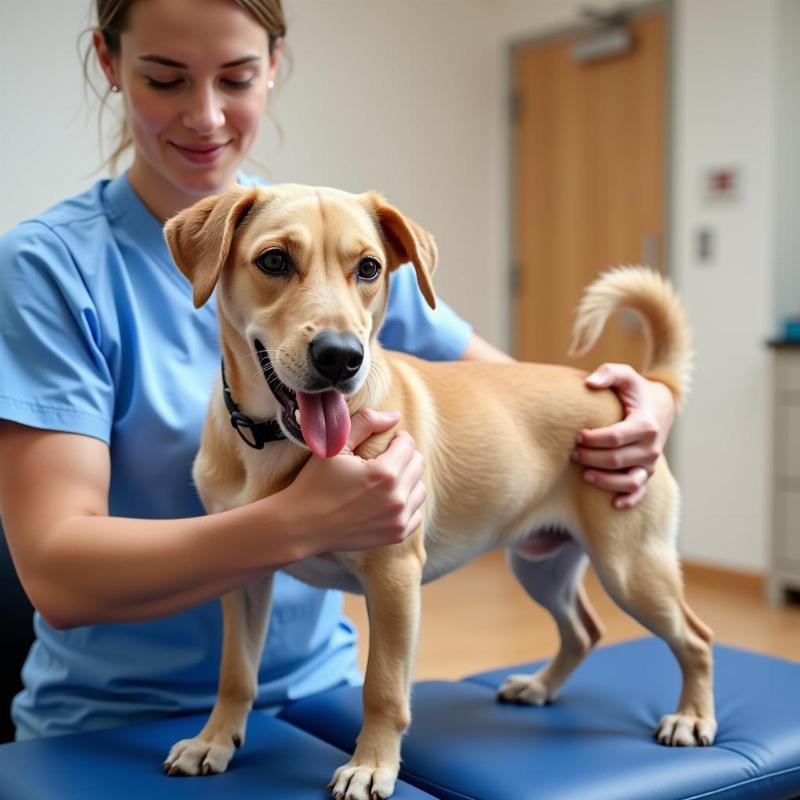If your dog yelps when you touch her back end, it’s a clear sign that something is bothering her. This reaction indicates pain or discomfort, and it’s crucial to identify the underlying cause to provide appropriate care. This article will explore the various reasons why your dog might yelp when you touch her back end, from common issues like arthritis to more serious conditions requiring veterinary attention. We’ll also discuss what you can do to help alleviate your furry friend’s discomfort and when it’s time to seek professional help.
Understanding Why Your Dog Reacts to Touch
Dogs communicate primarily through body language, and vocalizations like yelping are often indicative of pain or distress. When your dog yelps upon being touched near her rear, it’s her way of telling you something isn’t right. Ignoring this signal could lead to further complications and unnecessary suffering for your pet. Understanding the potential causes is the first step toward effective treatment and ensuring your dog’s well-being.
Common Causes of Back End Pain in Dogs
Several common issues can cause discomfort in a dog’s hindquarters, leading them to yelp when touched. These include:
- Arthritis: As dogs age, they can develop arthritis, a degenerative joint disease that causes pain and stiffness, especially in the hips and lower back. This pain can be exacerbated by touch.
- Hip Dysplasia: This inherited condition affects the hip joint, leading to instability and pain. It’s more prevalent in larger breeds and can cause yelping when the area is touched.
- Muscle Strains or Sprains: Just like humans, dogs can pull or strain muscles in their back end, resulting in pain and sensitivity to touch.
- Anal Gland Problems: Impacted or infected anal glands can be extremely uncomfortable for dogs and cause them to yelp, especially if the area is touched directly or indirectly.
- Injuries: A fall, rough play, or even a simple stumble can result in injuries to the back, hips, or tail, causing pain and yelping upon contact.
When to Seek Veterinary Attention
While some causes of back end pain might be minor, others can be serious and require immediate veterinary attention. Contact your veterinarian if your dog:
- Exhibits sudden onset of yelping or pain
- Shows signs of lethargy or loss of appetite
- Has difficulty walking or standing
- Has swelling or redness in the affected area
- Continues to yelp even after rest
Diagnosing the Cause of Yelping
Your veterinarian will conduct a thorough physical examination and may recommend diagnostic tests such as X-rays or blood work to pinpoint the exact cause of your dog’s discomfort. Accurate diagnosis is essential for developing an effective treatment plan.
Treatment Options for Back End Pain in Dogs
Treatment will vary depending on the underlying cause. It might include:
- Medication: Pain relievers, anti-inflammatory drugs, or antibiotics may be prescribed to manage pain and infection.
- Physical Therapy: Exercises and stretches can help improve mobility and strengthen muscles.
- Surgery: In severe cases of hip dysplasia or other injuries, surgery might be necessary.
- Supplements: Certain supplements, like glucosamine and chondroitin, can help support joint health.
 Dog Receiving Physical Therapy for Back End Pain
Dog Receiving Physical Therapy for Back End Pain
Home Care Tips for a Dog Yelping When Touched
While veterinary care is crucial, you can also take steps at home to help your dog feel more comfortable:
- Provide a comfortable resting area: Ensure your dog has a soft, supportive bed.
- Apply heat or cold packs: Consult your veterinarian for guidance on whether heat or cold therapy is appropriate for your dog’s condition.
- Gentle massage: If your vet approves, gentle massage can help soothe sore muscles. Avoid applying pressure directly to the painful area.
- Weight management: Maintaining a healthy weight can reduce stress on joints.
Conclusion
If your dog yelps when you touch her back end, don’t ignore it. This vocalization is a sign of discomfort and could indicate a variety of underlying issues. By seeking veterinary care and implementing appropriate treatment, you can help alleviate your dog’s pain and improve her quality of life. Remember, early intervention is key to managing many conditions effectively.
FAQ
-
Q: My dog yelps only sometimes when I touch her back end. Should I still be concerned?
- A: Yes, even intermittent yelping warrants a veterinary checkup. It could indicate a developing problem.
-
Q: Can certain dog breeds be more prone to back end problems?
- A: Yes, larger breeds are often more susceptible to hip dysplasia and other joint issues.
-
Q: How can I prevent back end problems in my dog?
- A: Maintaining a healthy weight, providing regular exercise, and ensuring a proper diet can help promote joint health.
-
Q: Is it okay to give my dog over-the-counter pain medication?
- A: No, never give your dog human medication without consulting a veterinarian. Many human medications are toxic to dogs.
-
Q: What should I do if my dog’s yelping suddenly gets worse?
- A: Contact your veterinarian immediately. This could indicate a serious problem.
-
Q: How long will it take for my dog’s back end pain to resolve?
- A: The recovery time depends on the underlying cause and the prescribed treatment. Your veterinarian can provide a more accurate timeframe.
Beautdogs.us is your premier resource for all things dog-related in the US. We offer expert advice on dog breeds, care, and products, catering to both new and experienced dog owners. Our goal is to empower you with the knowledge and resources you need to provide the best possible care for your beloved canine companion. For more helpful tips and expert advice, contact us today! Email: [email protected], Phone: +1 501-555-7529. Visit Beautdogs.us for more information.